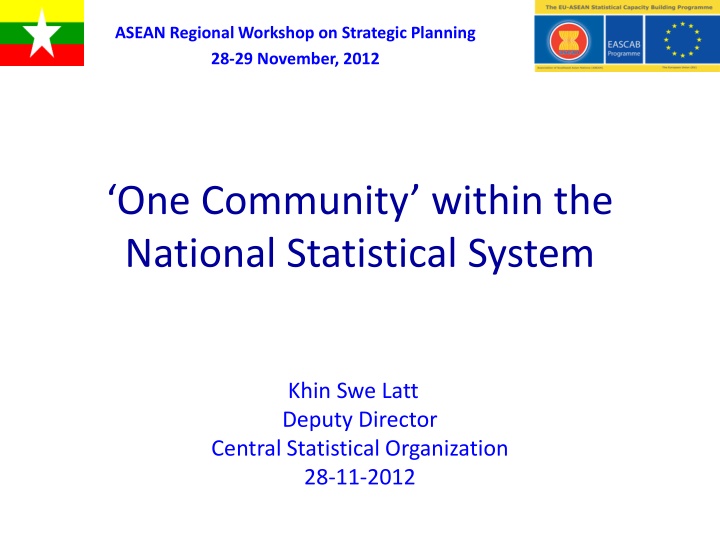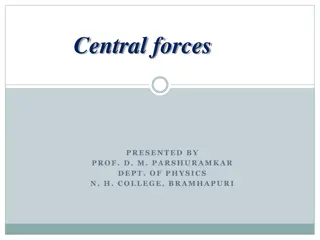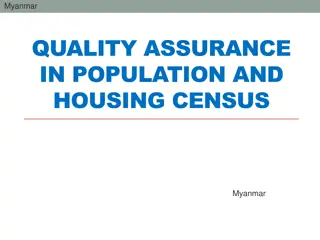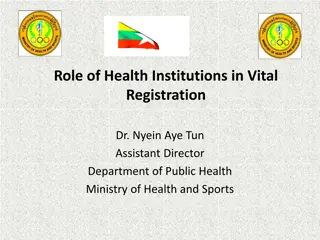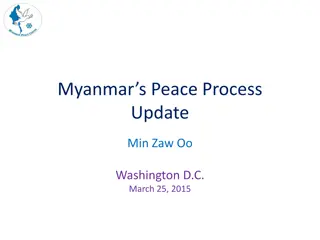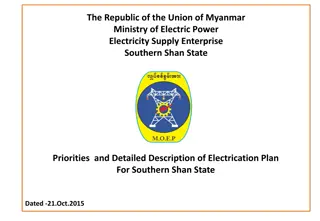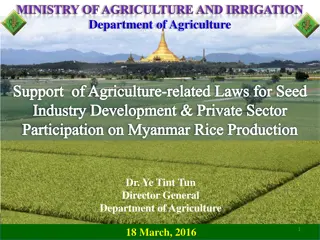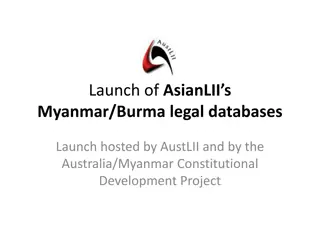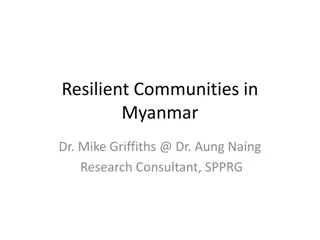Overview of Myanmar Statistical System and Central Statistical Organization
The Myanmar Statistical System operates as a decentralized system with the Central Statistical Organization playing a crucial role at the national level. Various surveys and data collection efforts are undertaken by different ministries and agencies, coordinated by the CSO. The CSO compiles and presents official statistics like the Statistical Yearbook, Monthly Economic Indicators, and sector-specific statistics to facilitate monitoring and planning. Their activities include producing socio-economic statistics, conducting surveys, and collaborating with government agencies.
Download Presentation

Please find below an Image/Link to download the presentation.
The content on the website is provided AS IS for your information and personal use only. It may not be sold, licensed, or shared on other websites without obtaining consent from the author.If you encounter any issues during the download, it is possible that the publisher has removed the file from their server.
You are allowed to download the files provided on this website for personal or commercial use, subject to the condition that they are used lawfully. All files are the property of their respective owners.
The content on the website is provided AS IS for your information and personal use only. It may not be sold, licensed, or shared on other websites without obtaining consent from the author.
E N D
Presentation Transcript
ASEAN Regional Workshop on Strategic Planning 28-29 November, 2012 One Community within the National Statistical System Khin Swe Latt Deputy Director Central Statistical Organization 28-11-2012
Objective To have a clear picture on how statistical offices are coordinating in the development of official statistics as a community within the national statistical system and how that impacts on regional cooperation.
Myanmar Statistical System Since the Statistics Law was enacted in 1952, Myanmar Statistical System has been operating as a decentralized system with the Central Statistical Organization functioning at a national level. In this system, the major surveys are conducted by CSO and produce general-purpose statistics such as Trade Statistics, Vital Statistics, Price Statistics , etc. But the sector-specific surveys and administrative records production are also undertaken by some ministries such as Ministry of Agriculture, Ministry of Industry, Ministry of Conservation and Forestry, Ministry of Health , etc by setting up their own planning and statistics departments. And there are many other departments which have statistical units to meet their needs as well.
About CSO Within the framework of the decentralized system, line ministries and agencies collect primary data. CSO closely deals with 134 government agencies in 31 ministries to compile data and publish the following official statistics: (a) Statistical Yearbook (Annual) (b) Selected Monthly Economic Indicator (Monthly) (c) Agricultural Statistics (Once in 3 years) (d) Forestry Statistics (Once in 3 years) (e) Livestock and Fisheries Statistics (Once in 3 years) (f) Profile of Children and Women (Once in 3 years)
Activities of CSO Central Statistical Organization (CSO) is producing and disseminating socio-economic statistics for the private and public use to be able to monitor, evaluate and analyze for management and planning. CSO is mainly responsible for compiling and presenting the price statistics and external trade statistics on weekly and monthly basis. CSO conducts household income and expenditure survey and private industrial establishment survey for industry zone on a regular basis. Moreover, nationwide surveys on Informal Sector Survey, Fertility and Mortality Survey, Price Survey, Private Industrial Survey and Rural Development Survey on ad-hoc basis.
How CSO is Producing Statistics? CSO collects and compiles various kind of statistics by means of three different ways. CSO itself collects and compiles the data by conducting ad-hoc or regular surveys both regionally or nationally. Some data are collected and compiled by CSO in collaboration with other departments. The other way to collect and compile the data is by asking or requesting data from concerned departments according to Statistical Authority Act 34 of 1952. The data is coming from administrative records. Once we have administrative data, CSO does the secondary compilation. After we have collected survey data, CSO usually keys in the data, validate the data, process and produce the reports for analysis. Statistical Yearbook having been disseminated in CD-ROM version is available since 1998. CSO disseminate Selected Monthly Economic Indicators and some daily price statistics via internet (https://www.mnped.gov.mm).
Users of Statistics CSO provides statistics to the government, private and public, regional and international organizations. ASEAN Statistical Yearbook (CSO) o 121 Indicators (4 indicators partly, 2 collection process going on, 9 untouched) IMTS (11 category)(Custom Dept) SITS (5 category)(Central Bank) FDIS (Directorate of Investment and Company Registration) MDGs(25 indicators)(Planning Dept) ACPMS (CSO) Other ASEAN Statistics????(Unknown Sources) That s why CSO is currently working closely and consulting frequently with concerned line ministries who are responsible for producing primary data. Coordination is crucial in providing different subject areas.
Coordination and Cooperation CSO renders technical advices as a member of steering committee to the line ministries when they are conducting specific surveys; In order to get ease in collecting the data, CSO is coordinating with the line ministries by organizing the consultative meetings. CSO coorperates with the international organizations to organize seminars or workshops on statistics matter. Collaborate with Interantional cooperation for study visits, capacity building and statistical development. CSO collaborates with NGOs as well as INGOs to introduce the required courses for the staffs.
Challenges To response to the increased and more demand for statistics, we need to strengthen the institutional arrangements and mandate for cooperation and coordination in statistical development by implementing National Strategies for Development of Statistics with the aid of technical assistants in which we need to revise the existing Statistical Act (1952). to advocate on statistical activities to raise the profile of statistics to improve data quality to improve data analysis and reporting to improve data dissemination and access
NSDS/SMP in South-East Asian countries Country NSDS/SMP SMP (2006-2015 ) under implementation Cambodia Indonesia Medium-term reform strategy (2010-2014) Lao PDR NSDS (2010-2020) approved in May 2010 under implementation No NSDS or SMP exists Myanmar Indonesia Medium-term reform strategy (2010-2014) Philippines Philippines Statistical Development Program completed (2011-2017), under adoption. 23 chapters covering different sectoral statistics Thailand NSDS/SMP with 16 sectoral SMPs Viet Nam Viet Nam Statistical Development Strategy (2011- 2020) under implementation 10 Kaushal Joshi , Senior Statistician ,Asian Development Bank-5 July 2012 /Nay Pyi Taw
How can we overcome the challenges? In order to meets the users satisfaction, the statistical processes should be in line with international practices while providing quality statistical products and the staffs producing such statistics should have great potential. That s why, there is a need for a change in the way statistical production and management is to be undertaken in our country. And CSO is in the central /main position in the production of official statistics in Myanmar and I think if CSO is strengthened would be the starting point in the strengthening of the national statistical system.
Stronger Role of CSO in National Statistical System CSO shall represent a stronger focal point for national statistics. CSO shall lead in harmonization of statistical system in conformity with internationally prescribed classification in the production and dissemination of regionally comparable official statistics. CSO shall cooperate with international or regional organizations, in order to do harmonization through building capacity at a national level compilation of comparable and reliable official statistics. Use of international statistical standards To advocate, motivate , practice the use of international statistical standards in public and private sectors by CSO
Stronger Role of CSO in National Statistical System Coordination within and among ministries and departments To establish the central statistical committee lead by CSO Coverage and Quality of Data generated by Administrative System CSO shall administer to settle coverage and quality of data (administrative records) generated administrative systems by rules and regulation, standardization according to the law
RegionalStatistical System (ACSS) The national statistical system aims at provision of reliable, timely and comparable statistics to the ASEANSEC to ensure availability of regionally comparable data through a program of harmonization of statistics of the different subject areas. facilitate support in data sharing and ensure service delivery in the community. In this case, our national statistical system applies the principle of subsidiarity and therefore the development of ASEAN community statistics is solely based on the national statistical systems of the ASEAN member states.
Regional Cooperation According to AFCS(ASEAN Framework of Cooperation in Statistics), Myanmar CSO will coordinate the development and harmonization of ASEAN statistics produced by the national statistical system, including those produced by line ministries/departments or competent national authorities. also coordinate the provision of ASEAN statistics to stakeholders in ASEAN through the ASEANstats and function as the country focal point in matters related to the regional cooperation in statistics. engage in the endorsement of the policies and standards for the development and harmonization of ASEAN statistics formulated by the ASEANstats as well.
Outcome Provision of national statistics to the ASEANSEC. Strengthen technical capacities of national statistical offices, line ministries and other relevant agencies in harmonization of regional statistics through capacity building programs. Such capacity built will lead to production of regionally and internationally comparable ASEAN statistics that will contribute to the development of regional policies. Enhanced data comparisons among ASEAN community.
Conclusions In the long run cooperation is more powerful than controlling. 17
